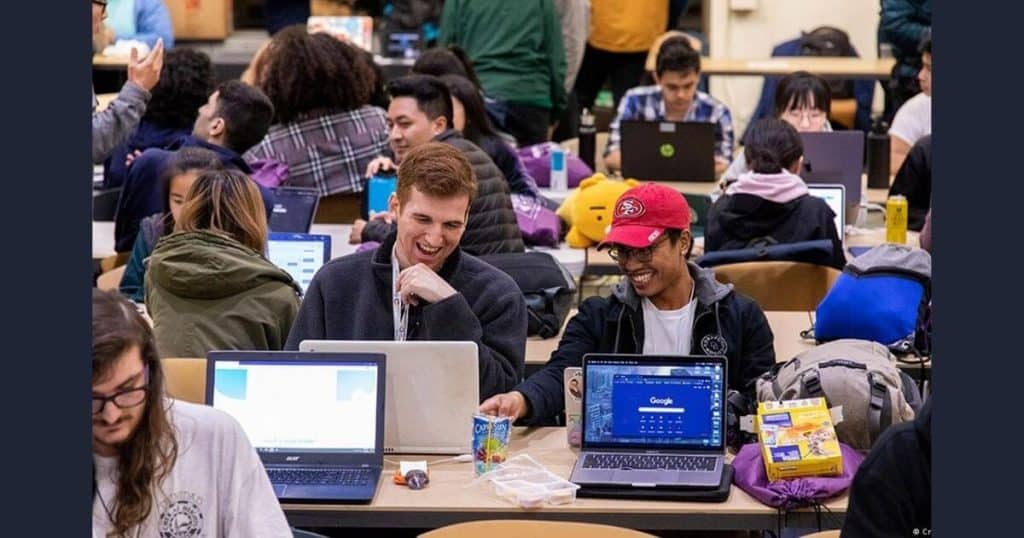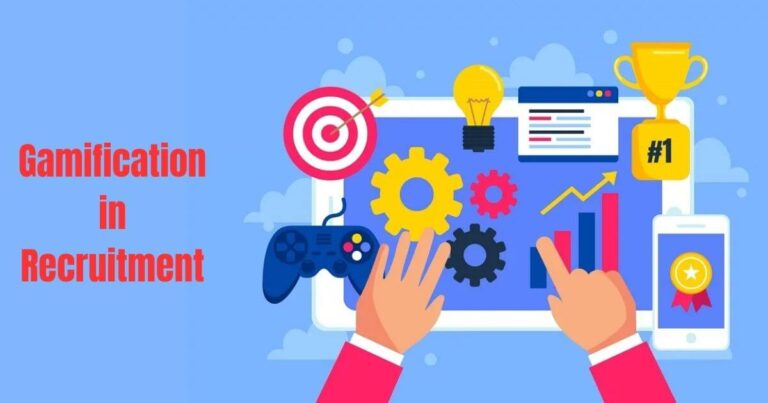Gamification in Recruitment: Revolutionizing the Way Companies Hire As technology advances, so do the methods used in recruiting and hiring new talent. One of the most innovative and effective ways companies leverage technology to attract top talent is through Gamification. This approach to recruitment involves integrating game-like elements into the hiring process to make it more engaging and enjoyable for candidates. We explore the benefits of Gamification in recruitment and how companies can implement this strategy to improve their hiring process.
The Benefits of Gamification in Recruitment
Increased engagement
One of the main benefits of Gamification in recruitment is increased candidate engagement. According to a study by BabbelforBusiness, gamify the work experience can boost employee engagement by as much as 60%. The same principle applies to the hiring process, as games and challenges make it more exciting for candidates. Incorporating Gamification into recruitment can increase the likelihood of candidates accepting your job offer and reduce the risk of dropouts. Get to know about free online resumes builder now.
Identification of critical skills and aptitudes
Gamification can also help recruiters to identify specific skills and talents in candidates that may not be apparent in a traditional interview. Recruitment games can evaluate skills such as problem-solving, innovative thinking, creativity, and time management. It enables recruiters to make more informed decisions about which candidates are the best fit for the job.
Improved candidate experience
Gamification can significantly improve the candidate experience during the hiring process. By making the process more enjoyable and interactive, you can leave a positive impression on candidates, which can help to strengthen your employer brand. Candidates are more likely to recommend your company to others if they have had a positive experience during the hiring process. Furthermore, Gamification can create a level playing field for candidates, as it tests their skills and abilities rather than their educational background or prior work experience.
Increased brand awareness
By using Gamification in recruitment, you can create a unique and memorable experience for candidates. It can help your company to stand out from competitors and increase brand awareness. Playful games can project an enjoyable company culture, thus attracting more quality candidates.
Improved efficiency
Gamification can also make the hiring process more efficient and seamless. Recruitment games can be used to evaluate candidates, reducing the time and resources required for traditional interviews. Moreover, Gamification can improve the candidate experience by providing timely feedback on their performance during recruitment.
Assessment of skills and behaviors
Gamification can allow recruiters to observe specific skills and behaviors that are difficult to see in a traditional interview. Candidates can be inclined to plan and memorize their answers to interview questions, while the recruiter’s objective is to assess the candidate. In recruitment games, however, predicting the challenges or tasks that a candidate will face is challenging, which creates a level playing field and allows recruiters to assess candidates’ basic skills and behaviors. Get to know How to organize a virtual event.
Different Types of Gamification in Recruitment
As businesses aim to improve recruitment, many turn to Gamification to attract and engage potential candidates. According to a report by Forbes, the global gamification market was valued at $6.8 billion in 2018, and it is projected to grow at an impressive CAGR of 32% to become a $40 billion industry by 2024.
Games
One of the most common types of Gamification in recruitment is using games. Games can be used to attract quality candidates, screen applicants, and improve candidate sourcing. For example, in a case study, Dominos created a game app where anyone can make pizzas and learn their recipes. This strategy helped them hire some of the people who played the game. Another example is Google, which used a public riddle to attract candidates.
Hackathons
Hackathons are another popular way of using Gamification in recruitment. Different types of virtual, internal, or interactive hackathons can reduce the interview cycle and select suitable candidates offhand. It is prevalent in the IT sphere. For example, Facebook conducts a series of hackathons where developers can work together to solve problems and showcase their abilities. This strategy has helped Facebook recruit top talent and created some of its most popular features, such as the “like” button.

Coding Tests
Coding tests are a type of Gamification that assesses candidates’ technical abilities. Companies like Workable’s partner, HackerRank, and Codility, offer online programming exercises that allow candidates to showcase their coding skills. This approach objectively measures candidates’ coding proficiency and helps screen potential hires.
Self-Analysis and Intelligent Screening
Gamification can be used to assess a candidate’s ability to self-evaluate. Candidates tend to pre-plan their answers during interviews, while recruiters try to delve deeper into a candidate’s sentiment, behavior, and overall experience. Using Gamification to provide a scenario-based assessment or an online quiz can make a difference in recruitment.
Points, Badges, and Leaderboards
Adding points, badges, and leaderboards is a common way to encourage competition and track progress in the recruitment process. This approach can also make the recruitment process more enjoyable for candidates. For example, when using Gamification in recruiting, providing a feedback report to each candidate after the gamified assessment is recommended.
Virtual Reality
Virtual reality is a more innovative type of Gamification that can create a unique recruitment experience. This approach can provide candidates with a realistic preview of the job they are applying for and the company culture.
Implementation of Gamification in Recruitment
Attracting top talent is the dream of every company. However, finding and recruiting such talent is a challenging task. With the job market becoming more competitive, companies are turning to innovative ways to make their recruitment process more effective and engaging. One such method is Gamification in recruitment, which has recently gained popularity. By implementing Gamification in the recruitment process, companies can make it more interactive and enjoyable while projecting an attractive company culture, which might attract even better candidates. But how exactly does Gamification help in HR?
Gamification in HR is an engaging, creative way to get your employees engaged and productive. By incorporating gaming elements such as points, badges, leaderboards, and challenges into the recruitment process, Gamification can make the entire experience more enjoyable and less stressful for the candidates. Moreover, it allows candidates to showcase their skills and abilities more dynamically, giving recruiters a better idea of their potential. It makes the entire recruitment process more transparent and objective, eliminating the possibility of unconscious bias in the hiring process.
Gamification also allows recruiters to evaluate candidates more accurately and efficiently. By using cognitive testing and other game mechanics, recruiters can test the candidates’ behavior, attitude, and aptitude, allowing them to select candidates better. It also enables recruiters to shortlist only top-scoring candidates, ensuring they save time on vetting thousands of resumes for a particular job role. Moreover, Gamification allows the entire recruitment process to become more interactive and in-depth without the possibility of redundancy or complexity. It lets recruiters use several other channels and platforms, from online tools to social media. It opens new avenues for recruiters to reach candidates and promote their employer brand. By showcasing their innovative and creative side, companies can create a lasting impression on potential candidates, making their organization a more attractive workplace.
Furthermore, Gamification can help companies create a more engaging and enjoyable work environment. Companies can boost employee morale and productivity by incorporating gaming elements such as rewards, recognition, and social interaction into the workplace. It can lead to better employee retention rates and more positive company culture.
Challenges and Limitations of Gamification in Recruitment
Only some gamified things will automatically be good.
One of the challenges of Gamification is that it may only sometimes lead to better outcomes. While Gamification can improve engagement and candidate experience, it may not necessarily result in better hiring decisions. The focus of Gamification should be on enhancing the recruitment process and not just making it more entertaining. Therefore, it is essential to evaluate the effectiveness of Gamification and its impact on the recruitment process.
Cost of developing gamified assessments
Developing gamified assessments can be more expensive than traditional recruitment methods. Creating engaging and interactive games requires more time and resources, which can lead to additional costs. To overcome this challenge, employers should weigh the costs against the benefits of Gamification before deciding to adopt it.
Accessibility issues
Gamification in recruitment may not be suitable for all candidates, especially those with disabilities or processing difficulties. Certain games may have flashing imagery that can be difficult for some candidates to handle, while online games may screen out entire classes of workers who lack internet access.
Incentivizing winning over learning
One of the problems with Gamification is it can create false incentives that prioritize winning over other objectives. For example, Gamification can incentivize employees to ace tests rather than learn the material. To overcome this challenge, employers should design thoughtful programs that balance the need for engagement and entertainment with the goals of the recruitment process.
Lack of standardization
Another challenge of Gamification is the need for more standardization in the recruitment process. Gamification tools may vary in effectiveness and appropriateness for different roles or industries. It is essential to evaluate the effectiveness of varying gamification tools and customize them based on the organization’s specific needs.
Defining objectives
Employers need to define their objectives before implementing Gamification in recruitment. Understanding what they want to achieve with Gamification and how it fits into the overall recruitment strategy is essential. Without clear objectives, Gamification can distract from the recruitment process’s ultimate goal: hiring the best candidates.
Examples of Companies Using Gamification in Recruitment
Google Code Jam
Tech giant Google has used Google Code Jam, an international programming competition, to identify and hire the best coders and software engineers worldwide. The contest comprises several rounds of algorithmic challenges and problem-solving exercises. Participants can earn cash prizes, T-shirts, and, most importantly, the opportunity to showcase their skills to Google recruiters. Since its inception in 2003, the Google Code Jam has attracted thousands of participants and helped Google to identify and recruit top-notch talent.
My Marriott Hotel
Marriott International has developed an online game called My Marriott Hotel to attract and evaluate candidates for hotel management positions. The game simulates the daily operations of a hotel, such as managing inventory, hiring staff, and serving guests. Players can design and customize virtual hotels and compete to achieve high scores and unlock new levels. The game has successfully engaged potential candidates and given them a taste of what it’s like to work at Marriott.
The Unilever Future Leaders Program
Unilever, the Dutch-British consumer goods company, has implemented Gamification in its Future Leaders Program to attract and develop young talent. The program includes a series of online and offline challenges, quizzes, and assessments that test candidates’ skills, personality, and potential. Participants can earn points, badges, and rewards and interact with Unilever employees and alums. The program has been praised for its effectiveness in identifying and nurturing top performers and creating a positive brand image for Unilever.
Develteam
Telekom, a subsidiary of Deutsche Telekom, has used Gamification to attract and select candidates for its sales team. The company developed an online game called Develteam, in which players act as sales representatives and compete to sell virtual products and services. The competition assesses players’ communication, negotiation, and persuasion skills and provides feedback and coaching. The game has successfully attracted millennials and increased the quality of hires.
References
How to Use Gamification at Work (and Why It’s Beneficial) | Babbel for Business
https://codingcompetitions.withgoogle.com/codejam
https://careers.unilever.com/unilever-future-leaders-programme
